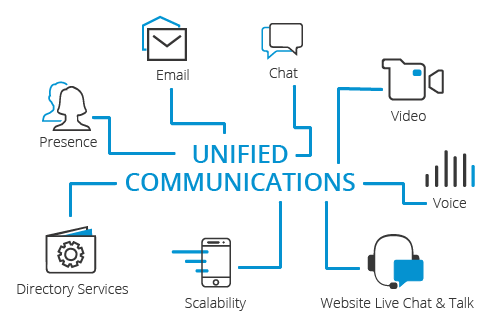UNIFIED COMMUNICATIONS
Unified communications (UC) is a business term describing the integration of enterprise communication services such as instant messaging, presence information, voice (including IP telephony), mobility features, audio, web & video conferencing, fixed-mobile convergence, desktop sharing, data sharing, call control and speech recognition with non-real-time communication services such as unified messaging (integrated voicemail, e-mail, SMS and fax).

UC is not necessarily a single product, but a set of products that provides a consistent unified user interface and user experience across multiple devices and media types.
Whether you are a small, medium or larger business, you do business in a world that offers the convenience of digital technology, and mobile workforces – it is a business landscape characterized by convergence, always-on connectivity, and the ability to service your customers with speed, efficiency and flexibility.
This means colleagues need to be able to share information in real-time, and engage effectively with your customers on any platform, on the device your customers choose to use.
Types of UC technologies and features
User-facing components of UC include the following technologies:
Text-based tools, such as email, text messaging and chat
Voice-based applications, such as telephony, voicemail and audio conferencing
Video-based services, such as desktop video conferencing, room-based video conferencing and telepresence
Web conferencing platforms, virtual meeting spaces and interactive whiteboards
Real-time presence
Enterprise social networking and collaboration platforms
On the Back-end, a strong communication system may comprise the following:
A single- or multivendor UC platform or server
A traditional, IP or cloud-based private branch exchange (PBX)
Devices such as phones, headsets, cameras and microphones, which are also user-facing tools
Business communication gateways, such as session border controllers (SBCs)
A multipoint control unit (MCU), or video bridge, for video conferencing with three or more endpoints Unified communications and collaboration tools overlap significantly. Collaboration tools often incorporate communication features, such as team chat, or integrate with external UC systems for those functions. UC also overlaps with contact center& technologies -- for example, in the form of automated call distribution (ACD), interactive voice response (IVR) systems, video chat and messaging capabilities.
Benefits of unified communications
By enabling users to communicate and collaborate in a more flexible and intuitive way, UC is often credited with increasing employee productivity and improving collaboration. Additionally, specific technologies, such as video conferencing, are also linked to reduced travel costs and enhanced ROI.
UC can help employees in a variety of contexts. Traditional office environments, for example, accommodate users on computers and equip employees with desk phones or softphones and desktop video conferencing. Conference rooms, too, are often equipped with speakerphones, a shared display system and video conferencing, which might be a traditional conferencing service or a high-end telepresence system.
The benefits of unified communications also stretch to remote employees who often work from mobile devices, including tablets and smartphones, and use audio and video capabilities and apps native to the device.
Solution
Jicho provides solutions for all your unified communications needs – from VoIP, video and data, through presence and conferencing to collaboration and unified messaging – Jicho has the solution for you.
Strategic planning
Session initiation protocol (SIP) trunking
VoIP (Voice over Internet Protocol)
Business communication gateways, such as session border controllers (SBCs)
Telephony
Directory services
Video and voice conferencing
Collaboration
Document management